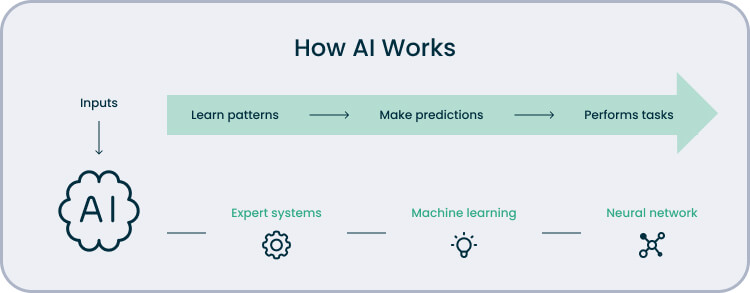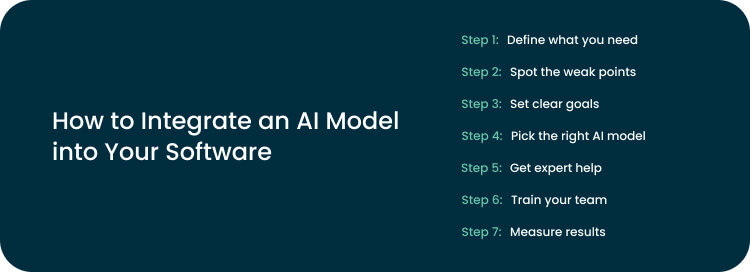AI models are everywhere. They’re writing code, generating product descriptions, and turning sketches into 3D designs. But are they valuable for your business? Spoiler: Yes. But only if you know how to use them.
How many AI models are there? According to TechCrunch, as of 2025, over 1.4 million AI models are hosted on Hugging Face alone. New ones pop up faster than you can start using existing models. Google dropped Gemini 2.5, and OpenAI followed with GPT-4o. Exciting? Sure. Overwhelming? Absolutely.
But if you’re a business owner or someone making product decisions, only one question matters: Can any of these models do something useful for my business?
Short answer? Yes. Long answer? Depends on the model and what you need.
For example, Cohere’s Aya Vision is a multilingual, multimodal AI that understands pictures and can describe them or answer questions about images. It also works well with many languages, not just English, which makes it a great fit for global brands.
Then there’s Stability AI’s 3D-from-2D model. You give it a picture, and it can turn it into a 3D scene with different camera angles. It’s not perfect yet, but with the right training data, it’s promising for gaming, real estate, and design.
Still, with so many AI models out there, it’s easy to feel lost. The good news? You’re in the right place. We’ll walk you through what these models can do for your business and which can fit your needs the best.
What Are AI Models: Definition and Key Concepts in Artificial Intelligence
Before we jump into the types of AI models, let’s clear up what they are. At its core, an AI model is a smart program trained to recognize patterns.
You feed it a ton of data, add some decision-making rules, and let it learn. Once it’s trained, it can spot patterns and make predictions all on its own. No humans are needed.
Each model has its own job, depending on the training data it’s been fed. Some pull together marketing reports. Others write code, scan documents for text, or fill out spreadsheets. The more examples a model sees during training, the better it gets at doing that task.
And yes, AI models are inspired by how we humans think. Some of them like conversational chatbots can even talk to you like a real person (creepy or cool? You decide). But others are way ahead of us: they can process data in seconds, spot patterns we’d never notice, and do routine tasks without getting bored or tired.
That’s why AI is such a big deal in business. It’s really good at doing the stuff we don’t want to (or can’t) do at scale.
Curious how AI models can work for your business? Let’s talk! Book a free consultation and discover which operations you can automate.
AI vs. Machine learning vs. Deep learning: understanding the differences
Artificial intelligence, machine learning, and deep learning: people use these terms like they’re the same thing. They’re not. They’re connected, yes. But they’re not interchangeable.
Think of it like this: if AI were a car, machine learning would be the engine. Deep learning? That’s the turbocharger inside the engine.
AI, machine learning, and deep learning rely on training data to work. So, they learn from examples to get smarter over time. They all work together to get you where you want to go, but each one plays a different role.

Artificial Intelligence (AI)
AI helps computers do tasks like humans. It lets them analyze, make decisions, and solve problems. AI is good at spotting patterns, following rules, and handling lots of data. It can answer questions, organize files, and find useful trends. And it does all of this faster and more accurately than people.
Machine Learning (ML)
Machine learning is a type of AI. It helps computers learn from data and get better over time without being reprogrammed. For example, it can learn to spot credit card fraud or predict when a device might break. It finds patterns in data and makes smart guesses based on them.
Deep Learning (DL)
Deep learning is a type of machine learning. It uses neural networks to process data in a way similar to the human brain. This allows computers to handle complex tasks like understanding speech, translating text, and creating images. It powers tools like voice assistants and face recognition.
They all connect and build on each other, but they’re not the same. Knowing how each one works helps you understand what kind of smart technology you might want to use in your next project.
How AI Models Work: Core Components and Functionality
The work of AI models follows a step-by-step process. Whether it’s answering your questions or spotting trends in data, AI models rely on structure, logic, and a lot of training data to work well.

Input and output
When you ask ChatGPT a question (input), it gives you a response (output). But between those two steps is a complex process powered by an AI model.
Goal and data collection
Every AI model starts with a clear goal: what it should do and what results it should produce. Programmers collect training data, ideally large and diverse, to teach the model how to perform the task.
Feeding the data
The data is fed into the model. The model uses algorithms (sets of rules) to analyze the data and look for patterns.
Neural networks
AI models are inspired by the human brain and contain nodes (data points) that connect to form a neural network. These networks map relationships between pieces of data and help the model “understand” what it’s learning.
Building the model
Multiple algorithms work together to form the full AI model. The model processes input, applies rules, and evaluates data to make predictions or decisions.
Producing output
Once trained, the model takes new input and generates output based on what it has learned. The more quality data it has, the more accurate its output.
Improving accuracy
If the results are off, programmers fine-tune the pretrained models. This can involve adding more training data or adjusting the algorithms.
In short, an AI model is built to learn from data, recognize patterns, and make smart decisions. And the better the training and fine-tuning, the smarter and more helpful it becomes.
Want to see how AI can support your business goals? Contact us for a free consultation, and we’ll show you where automation can bring the most value to your operations.
8 Types of AI Models to Fit Any Need – Which One Is Right For You?
Whether you’re building a chatbot, analyzing data, or automating content creation, there’s an AI model designed for the job. Here are the main types of AI models you can choose from, each with its strengths.
Language models (LLMs)
What they do: Language models are trained to read, understand, and generate text that sounds natural and human-like. The more data they’re trained on, the better they get at responding in a way that feels natural and relevant.
How they work: LLMs use deep learning techniques, especially a type of neural network called the transformer. These models analyze billions of words and phrases to learn grammar, facts, context, tone, and even humor.
Used for: Chatbots, content creation, email drafting, and coding help.
Examples: GPT-4 (OpenAI), Claude (Anthropic), Gemini (Google).
Vision models
What they do: Vision models are trained to “see” and make sense of visual information such as images, videos, and even live camera feeds. These models use mathematical patterns to interpret pixels and understand what’s in a picture.
How they work: Most vision models are built using convolutional neural networks (CNNs) or transformer-based architectures. They break down images into small parts, detect edges, shapes, colors, and compare those patterns with what they’ve learned from training data.
Used for: Object recognition, medical imaging, photo tagging, quality control.
Examples: Gemini Vision, GPT-4o with vision, OpenCV + YOLO.
Speech & audio models
What they do: Speech and audio models are designed to understand and generate human speech. They can convert spoken words into text (speech-to-text), read text out loud (text-to-speech), and even detect who is speaking or how they’re feeling.
How they work: These models use deep learning techniques such as recurrent neural networks (RNNs), transformers, or convolutional models that analyze audio waveforms. They break down sound into smaller pieces called spectrograms, then compare these sound patterns with what they’ve learned during training.
Used for: Voice assistants, transcription, customer service bots.
Examples: Whisper (OpenAI), Meta Voicebox, Google Speech-to-Text.
Generative models
What they do: Generative models are designed to create new content from scratch. They can write human-like text, generate original images, compose music, produce videos, design 3D models, and even write or complete code.
How they work: Generative models are usually built on architectures like Generative Adversarial Networks (GANs), Variational Autoencoders (VAEs), or transformer-based models like GPT. They learn from huge amounts of data and then use that knowledge to produce new outputs that follow similar styles or structures.
Used for: Art, design, marketing, product mockups, code generation.
Examples: DALL·E, Midjourney, Stable Diffusion, Copilot (by GitHub/OpenAI).
Predictive models
What they do: Predictive models analyze past data to make informed guesses about what might happen next. By finding patterns and trends in historical information, these models forecast future events, helping businesses and organizations prepare and make smarter decisions.
How they work: They use statistical methods and machine learning algorithms like decision trees, regression, or time-series analysis to identify relationships in data. The model learns from past examples and then applies that knowledge to predict future outcomes.
Used for: Sales forecasts, fraud detection, churn prediction.
Examples: XGBoost, Random Forest, ARIMA, Prophet (by Meta).
Recommendation models
What they do: Recommendation models analyze user behavior and preferences to suggest relevant products, content, or services. By understanding what users like or interact with, these models personalize experiences to help people discover things they might enjoy or find useful.
How they work: These models use techniques like collaborative filtering, content-based filtering, or hybrid methods that suggest content or products based on user behavior.
Used for: E-commerce, streaming platforms, and learning platforms.
Examples: Matrix Factorization, Neural Collaborative Filtering (NCF).
Decision models (reinforcement learning)
What they do: Decision models based on reinforcement learning learn how to make smart choices by interacting with their environment. They improve over time by trying different actions, seeing the results, and learning which actions lead to the best outcomes.
How they work: These models use algorithms that reward good decisions and penalize bad ones. The model observes the current situation, takes action, and receives feedback (a reward or penalty).
Used for: Robotics, game AI, autonomous vehicles, and dynamic pricing.
Examples: AlphaGo, OpenAI Five, DQN, PPO.
Multimodal models
What they do: Multimodal models can understand and process multiple types of data, like text, images, and audio, all within a single system. By combining these different types of information, they provide richer, more accurate responses and can perform complex tasks.
How they work: These models use advanced neural network architectures that integrate inputs from different modalities. For example, they analyze images with vision networks, process text with language models, and interpret audio signals.
Used for: Advanced assistants, content search, accessibility tech.
Examples: GPT-4o, Gemini 1.5, Claude 3 Opus.
Which AI model is right for you? Not sure where to start? Let’s talk! We’ll help you find the perfect AI solution tailored to your business goals.
Business Value of AI Models: How to Apply Them and Reap the Benefits
Now that you’re aware of the variety of AI models and know their functions, it’s high time to reveal why they matter to your business and how you can apply them to get real results. Here are some use cases we believe can be valuable for you:
Train AI models to tailor them to your business needs
AI models need data to learn. The more quality data you give them, the better they perform.
You can collect data from websites, sensors, cameras, or your systems. If you have access to data your competitors don’t, that’s a big advantage.
For example, in e-commerce, companies collect product photos and customer clicks to train AI that suggests items, improves search, and sorts products into the right categories.
Tip: Begin training your AI model with a focused dataset and a single business objective in mind.
Generate new data with AI models to produce multiple scenarios
AI models can also create data. That’s helpful when you don’t have enough real-world examples or want to test different scenarios.
This includes:
- Synthetic data: Fake, but realistic data used for training
- Data augmentation: Making small changes to existing data to expand it
- Creative generation: Creating images, designs, or ideas with tools like DALL·E
Tip: Generate new data to use when you need more training data or want to explore creative content.
Understand your data to make actionable decisions
Once a model is trained, it can make predictions or spot patterns in your data. This is called inference.
Examples:
- Predicting if a customer will leave
- Spotting fraud in payments
- Tracking people or products in videos
Tip: Use AI models when you need insights, predictions, or real-time analysis to make data-based decisions.
Automate tasks to speed up processes
AI can also do work for you. When added to a process or pipeline, it can handle tasks like:
- Analyzing customer behavior in real time
- Auto-tagging and categorizing new products
- Personalizing offers based on browsing and purchase history
- Detecting issues in order processing or inventory tracking
Tip: We recommend using AI models if you want to streamline operations and free your team from routine tasks.
With AI models, your business can work faster, spend less, and make smarter decisions, all of which help you stay competitive. Stay tuned as we break down the latest AI models and how to apply them to your business.
Top AI Models You Should Know and Actually Use
With so many AI models flooding the market, it can be hard to tell which ones truly stand out.
To help you keep up, here are 5 of the top AI models right now: what they can do, how they’re used, and why they can work for you.
GPT-4o (OpenAI)

Why it’s top: Best-in-class multimodal performance with fast response time and broad language support.
Strengths: Text, image, audio, and video processing; fast (232 ms audio input response)
Use Cases: Translation, text/image generation, coding, summarization
Benchmarks: Top scores in math, coding, reasoning
Availability: Free with limited access; full access via Plus/Team/Pro
Cost: $3.75M input / $15M output tokens
OpenAI o1

Why it’s top: Surpasses GPT-4o in advanced reasoning and academic benchmarks.
Strengths: Step-by-step problem-solving, learns from mistakes
Use Cases: Complex math, quantum computing, data analysis in healthcare
Benchmarks: Competes with human experts in math, law, science
Availability: Team, Pro, and Enterprise ChatGPT accounts
Cost: $15M input / $60M output tokens
Claude 3.7 Sonnet (Anthropic)

Why it’s top: Highly capable in real-world coding and agent-based workflows.
Strengths: Extended thinking mode, detailed reasoning
Use Cases: Coding, automation, chatbot building, data insights
Benchmarks: Strong in software engineering and agentic tools
Availability: Claude.ai, Amazon Bedrock, Google Cloud
Cost: $3M input / $15M output tokens
Gemini 2.5 Pro (Google)

Why it’s top: Powerful for large-scale data processing and creative coding.
Strengths: 1M token context, advanced reasoning
Use Cases: Web dev, animations, games, visualizations
Benchmarks: Top-tier in physics, math, coding
Availability: Gemini API, Google Studio, Vertex AI
Cost: $2.50M input / $15M output tokens
OpenAI o3-mini

Why it’s top: Most cost-efficient for strong STEM and coding tasks.
Strengths: Reasoning modes (low/medium/high), function calling, safety-aware
Use Cases: STEM research, image Q&A, advanced coding
Benchmarks: High in math, science, programming
Availability: ChatGPT Team & API (tiers 1–5)
Cost: $1.10M input / $4.40M output tokens
These 5 models are leading the way in AI. Whether you need help with coding, writing, or solving complex problems, there’s a model here that can do the job.
Need help choosing the right AI model for your project? Reach out to our team for a free consultation.
How to Integrate an AI Model into Your Software
Integrating AI into your app doesn’t have to be complicated. But it does take more than just picking a fancy tool. You need a plan, a clear goal, and a team that’s ready for it. Here’s a simple step-by-step guide to help you get started:

- Step 1. Define what you need: Answer the following question: What’s the problem you’re trying to solve? Start by getting clear on what AI should do for you.
- Step 2. Spot the weak points: Look at where your business could run smoother. Are your support teams overloaded? Is your content creation slow? These are great areas to start testing AI solutions.
- Step 3. Set clear goals: Don’t just say “we want to be more efficient.” Say something like, “we want to cut response time by 30% in 3 months.” Make your goals specific and measurable so you know what success looks like.
- Step 4. Pick the right AI model: Not every model fits every business. Find one that matches your needs, works well with your current systems, and is easy to scale. Read reviews, ask for demos, and don’t be afraid to test before you commit.
- Step 5. Get expert help: AI can be tricky, don’t go it alone. Our team can help you find the right solution, set it up properly, and guide your team through the process.
- Step 6. Train your team: Tech is only useful if your team knows how to use it. Help them understand what AI can do, how it affects their day-to-day work, and how to make the most of it. At Forbytes, we even run an internal AI community to support our developers in learning and growing.
- Step 7: Measure results: Once AI is up and running, check in regularly. Is it doing what you expected? Is it helping your team and customers? Collect feedback and adjust as needed to keep things moving in the right direction.
Ready to Turn Smart Technology into Your Business Advantage?
All in all, bringing AI into your business is worth the effort. With the right AI models in place, you can boost productivity, improve customer service, make smarter decisions, and run your operations more smoothly. The key is to have a clear step-by-step plan and stick to it.
If you want to stay ahead of the competition, now’s the time to build your AI strategy and start integrating the tools that fit your business.
Need help with AI consulting or integration? At Forbytes, our AI and machine learning engineers are here to help. We’ll find the right AI models for your needs and fuel your system with smart technology to make it faster, sharper, and more competitive.
Let’s talk. Reach out, and we’ll get back to you to discuss the next steps.

Our Engineers
Can Help
Are you ready to discover all benefits of running a business in the digital era?

Our Engineers
Can Help
Are you ready to discover all benefits of running a business in the digital era?







